
|
Geological Survey Professional Paper 160
Geologic History of the Yosemite Valley |
GEOGRAPHIC SKETCH OF THE YOSEMITE REGION AND THE SIERRA NEVADA
(continued)
THE YOSEMITE VALLEY IN DETAIL
In the preliminary sketch on page 7 the Yosemite was described as a broadly U-shaped chasm having sheer, spurless walls and an almost level floor. In detail, however, the valley is far from having the geometric simplicity of form that might be suggested by this characterization. Its sides are not strictly parallel throughout, nor do they consist of monotonous blank walls. They are diversified by a host of boldly sculptured features and in addition are adorned by waterfalls. The Yosemite, indeed, owes its unique place among the valleys of the world to its wealth of monumental rock masses and the splendor and variety of its falling waters, as much as to its general form.
PECULIAR MODELING OF VALLEY
The bird's-eye view on Plate 15, which shows the Yosemite Valley as it would look from an airplane, reveals the fact that its sides, though remarkably sheer in places, are at no point strictly vertical throughout their height. Almost everywhere the declivities are broken by slopes or ledges, and as a consequence the bases of the wails project considerably beyond the tops. The topographic map (pl. 7) shows by actual measurement that the horizontal distance from top to base of the walls averages more than half a mile. Even at those points where the cliffs are most sheer the horizontal distance is considerably greater than a mere "stone's throw." The cliffs below Glacier Point, which are noted for their abruptness, rise 3,200 feet in a distance of a quarter of a mile. El Capitan (pl. 3), the boldest of all the rock masses that flank the valley, rises 3,000 feet in a distance of 600 feet. Because of this lack of real verticality of its sides the Yosemite is less than half as wide at the bottom as it is at the top; from brink to brink it measures 2 miles across, but its floor, measured from cliff base to cliff base, is less than a mile wide. In places the talus slopes reduce it to less than half a mile.

|
| PLATE 15.—BIRD'S-EYE VIEW OF YOSEMITE VALLEY AND THE HIGH SIERRA. Drawn by C. A. Weckerly. (click on image for an enlargement in a new window) |
The Yosemite Valley is divided by a marked constriction about a third of the way from its lower end, between El Capitan and the great promontory of which the Cathedral Rocks are the main summits. (See pls. 3 and 15.) This is the imposing portal that never fails to impress the incoming traveler with the stupendous scale on which the Yosemite is built. El Capitan really juts out but little from the north wall, but the Cathedral Rocks project fully a mile from the south wall. The Yosemite Valley, accordingly, consists of two broad chambers connected by a portal. The lower and smaller chamber is the less impressive of the two, being inclosed only in part by precipitous cliffs, in part by long and rather monotonous slopes of rock waste. These slopes nevertheless have a redeeming quality that deserves to be acknowledged; they have enabled man to build roads from the uplands down to the valley floor—the Big Oak Flat Road on the north side, the Wawona Road on the south side. In no other part of the Yosemite would it have been possible to construct roads making a descent of 2,000 or 3,000 feet without tunneling through the cliffs.
The lower end of the valley is in the main spoon-shaped. It is closed off by a slope of solid rock about 800 feet in height which is cut only by the narrow, steep-walled gorge through which the Merced River leaves the valley. (See pl. 16, A.) This rock slope leads up to high rock benches that extend along both sides of the Merced Gorge for several miles.

|
|
PLATE 16.—A (top), LOWER END OF THE YOSEMITE
VALLEY AND HEAD OF MERCED GORGE. This view from the Big Oak Flat Road
shows the sloping barrier of massive granite that incloses the
spoon-shaped end of the valley. B (bottom), HEAD OF YOSEMITE VALLEY, FROM COLUMBIA ROCK. In the center is the great head wall, surmounted by Half Dome. At the right is the promontory of Glacier Point, which conceals the upper canyon of the Merced. At the left are North Dome, the Royal Arches, the Washington Column, and the mouth of Tenaya Canyon. Photograph by J. T. Boysen. |
The upper or main chamber of the Yosemite Valley is 5-1/2 miles long and has a sinuous course. Its sides are on the whole remarkably equidistant and, although carved in a multitude of spectacular features, have the appearance of being planed off parallel to each other. The salients on one side, indeed, correspond roughly to the embayments on the other side—a fact which doubtless strengthened Clarence King's conviction that the chasm is a rent in the earth whose sides had been torn apart. There is nevertheless considerable variation in width from point to point. Immediately above the portal at El Capitan, which is about half a mile wide, the width from cliff base to cliff base increases to a maximum of more than 1 mile. Farther up it contracts to 3,500 feet, then to 3,000 feet, and finally it widens again to a full mile at the upper end of the valley.
Most strangely modeled is the valley head. (See pl. 16, B.) It is squared off, at right angles to the sides, by a high, straight rock wall a mile in length. At the north end of this wall is the broad U-shaped mouth of Tenaya Canyon; at the south end opens the narrow, tortuous gorge through which the Merced River descends from the Little Yosemite. Except for these two openings the head of the valley is bordered by continuous, massive cliffs. These cliffs, moreover, rise sheer almost directly from the valley floor, their bases being masked only by small piles of débris. As a result the valley head has a peculiar boxed-in appearance which, it must be admitted, is more suggestive of the subsidence of a block of the earth's crust, in the manner postulated by Whitney, than of the erosive action of either streams or glaciers.
CLIFFS AND ROCK MONUMENTS
The Yosemite Valley owes its scenic character not merely to its great depth and unusual form, but in large measure to the distinctive sculpture of its walls. The rock forms are astonishingly varied in design—some massive, colossal, and simple in outline, others frail and intricately chiseled; some conspicuous for their boldness, others carved in bas-relief—and many of them, have arresting individuality. They are of such singularly clean-cut, monumental character that they impress themselves upon the memory of the beholder at once and forever. Some have become famed the world over.
El Capitan (see pls. 3 and 17) stands preeminent among the massive, bulky forms. Its majestic cliff rises from the valley with so simple a sweep of line that its height is peculiarly difficult to evaluate at a glance. The estimates of the first white men to camp at the foot of El Capitan mow seem ludicrous. As is related by Bunnell25 in his account of the discovery of the Yosemite Valley by the Mariposa Battalion, "one official estimated El Capitan at 400 feet; Captain Boling at 800 feet. * * * My estimate was a sheer perpendicularity of at least 1,500 feet." Trigonometric measurements made in connection with the survey for the topographic map of the valley (pl. 7) have determined the height of the cliff, from its toe to the brow at the top, to be fully 3,000 feet. The dome-shaped crown above the brow rises 500 feet higher.
25Bunnell, L. H., Discovery of the Yosemite and the Indian War of 1851, 4th ed., p. 94, 1911.
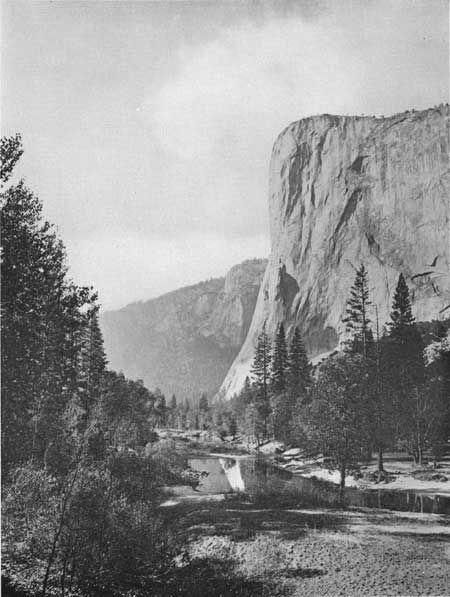
|
| PLATE 17.—EL CAPITAN, FROM THE EAST. The 3,000-foot-cliff is the highest in the Yosemite Valley and one of the highest in the world. The salient is composed throughout of unfractured massive granite. The gray blotches on the wall at the right are due to masses of diorite that invaded the granite. A pine tree about 100 feet high stands in the niche with overhanging roof a short distance above the bushy slope at the base. Photograph by J. K. Hillers. |
Opposite El Capitan is the ponderous group of the Cathedral Rocks (pls. 3 and 18), which project more than a mile out into the valley. The three summits, carved from a single asymmetric ridge, loom one above another in an ascending series. They stand 1,650, 2,590, and 2,680 feet, respectively, above the valley floor. On the west side they slope evenly to the V-shaped gulch though which the waters of Bridalveil Creek race down to the precipice of the Bridalveil Fall. Parallel to them, on the opposite side of the gulch, is a lesser ridge whose main summit is known as the Leaning Tower (see pl. 15), because it actually leans out over the 1,200-foot precipice beneath it.
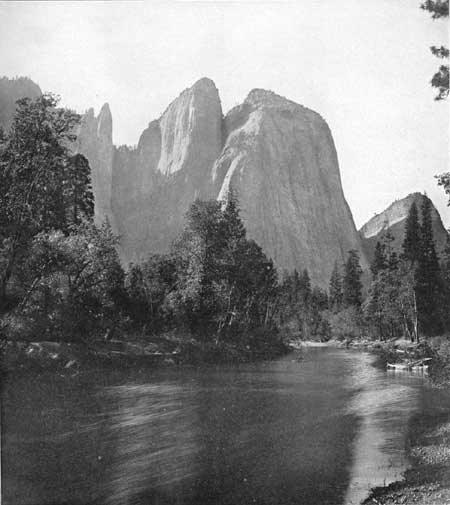
|
| PLATE 18.—CATHEDRAL ROCKS AND CATHEDRAL SPIRES. The Cathedral Rocks are among the most massive rock forms in the valley; the Cathedral Spires are among the frailest. On the summits of the Cathedral Rocks lie glacial boulders which show that the ancient Yosemite Glacier once completely overwhelmed these rock masses. Photograph by J. K. Hillers. |
In the embayment east of the Cathedral Rocks, offering a striking contrast to those massive piles, stand the two slender, tapering shafts of the Cathedral Spires, the frailest of all the rock forms in the valley. They rise to heights of 2,160 and 1,950 feet, above its floor. Farther east are a multitude of finely chiseled, hackly forms, followed by a series of strongly asymmetric spurs, with smooth slopes on the west side and vertical or overhanging cliffs on the east side. The spur under Taft Point is a notable example, but the asymmetric type of sculpture reaches its finest development on the opposite side of the valley, in the group of the Three Brothers (pl. 19, B), whose gabled forms rise one above another, all pitching at the same angle.
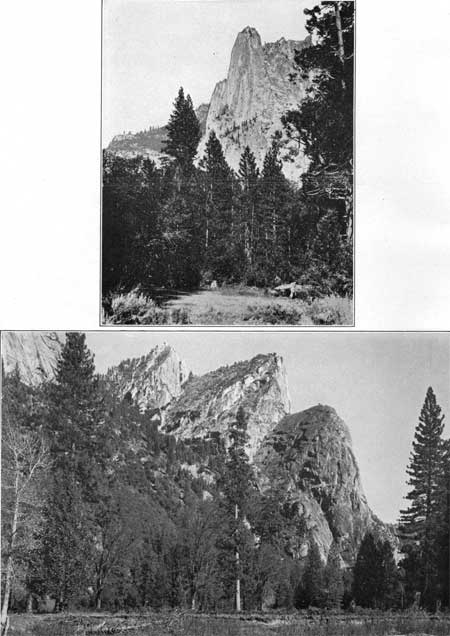
|
|
PLATE 19.—A (top), SENTINEL ROCK. The
smooth, sheer front of this tall shaft is determined by nearly vertical
joint fractures. Photograph by F. C. Calkins. B (bottom), THE THREE BROTHERS. This group is remarkable for its strongly asymmetric forms, which are due to the splitting of the rock along oblique master joints. Photography by F. C. Calkins. |
Still farther up in the valley vertical and horizontal lines of sculpture predominate. Sentinel Rock (pl. 19, A) stands forth from the south wall like an obelisk with sheer front and sharp, splintered top. The great cliff over which the Upper Yosemite Fall leaps is nearly vertical, and so is the rock wall to the west of it, which dominates the zigzag trail to the top of the fall. Below, on both sides of the recess in which the Lower Yosemite Fall descends, are two horizontal rock terraces with sheer fronts. Most impressive of all for height and verticality is the famous cliff at Glacier Point. It is a straight wall, a quarter of a mile long and 1,000 feet high, that terminates the promontory as abruptly as if it had been cut with a cyclopean knife. That it is really vertical, and not merely inclined at a high angle, as are the majority of the cliffs that are popularly termed sheer or vertical, is evident from the silhouette profile in Plate 20, B. It is this absolute verticality of the rock face that permits the "fire fall," which customarily is produced every night during the tourist season by pushing the glowing embers of a bonfire from the edge of the platform above, to descend through space untrammeled, deploying gradually like a waterfall of the Yosemite type.
At the extreme top of the precipice. which is 3,200 feet above the valley, there projects a large, rough slab—the famous "overhanging rock of Glacier Point." (See pl. 9, B.) A short distance to the west of it is a second, smaller overhanging rock, known as Photographer's Rock, because it affords a convenient base from which the venturesome ones on the main overhang may be photographed. It is the Photographer's Rock which appears in the Silhouette profile shown on Plate 20, B.

|
|
PLATE 20.—A (left), NORTH DOME, FROM MERCED
RIVER NEAR HAPPY ISLES. This dome was repeatedly overridden by the
glaciers, yet it does not differ materially in general form from
Sentinel Dome, which was not overriden. Photograph by F. C.
Calkins. B (right), SILHOUETTE PROFILE OF CLIFF AT GLACIER POINT. The man at the top stands on Photographers Rock, the smaller of the two overhanging slabs at the edge of the great precipice. In the background is Half Dome. Photograph by A. C. Pillsbury. |
The most remarkable rock forms cluster about the head of the Yosemite Valley. Directly opposite Glacier Point are the Royal Arches (see pl. 21, B), a series of immense natural arches carved in bas-relief, one within another, in a slanting rock face 1,500 feet in height. Flanking them, as a corner post at the mouth of Tenaya Canyon stands the Washington Column, a colossal upright pillar 1,700 feet in height; and surmounting them is the North Dome (see pls. 16, B, and 20, A), a smoothly rounded, helmet-shaped mass of bare granite that rises to a height of 3,530 feet above the valley. A short distance to the northeast is Basket Dome, a less symmetrical dome of the same general type.
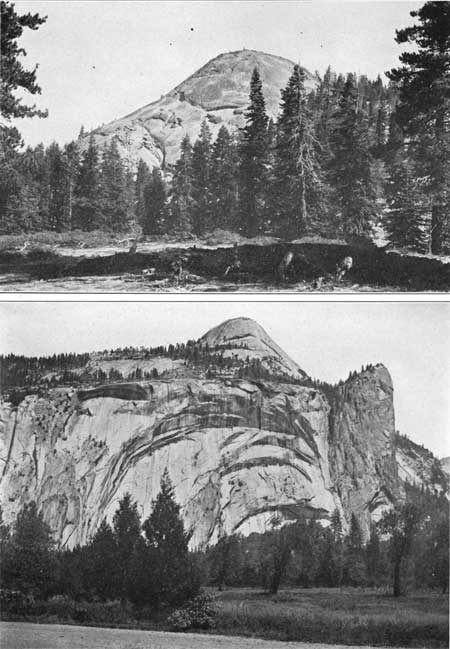
|
|
PLATE 21.—A (top), SENTINEL DOME. A typical
dome of massive granite that owes its rounded form wholly to
exfoliation—the casting off of successive shells. It has not been
overridden by the glaciers of the ice age. Photograph by F. C.
Calkins. B (bottom), THE ROYAL ARCHES AND THE WASHINGTON COLUMN SURMOUNTED BY NORTH DOME. The Royal Arches are sculptured in a slanting cliff face 1,500 feet high. North Dome rises 2,000 feet higher. The dark streak on the cliff at the left indicates the path of the little Royal Arch Cascades. |
Dome-shaped features of bare granite abound in the upper Yosemite region. Most readily accessible to the sightseer is Sentinel Dome (pl. 21, A), which stands on the upland, to the southwest of Glacier Point. Highest of all, and least accessible, is Mount Starr Ring (pl. 32, A), the beautifully symmetrical, egg-shaped dome east of the Illilouette Valley. It is surrounded by several less conspicuous domes that seem almost insignificant in comparison with it, though each of them is larger, actually, than Sentinel Dome. To the general category of domes belong also Mount Broderick and Liberty Cap (pl. 44), the two bosses of granite that obstruct the mouth of the Little Yosemite; the Cascade Cliffs (pl. 45, A), Bunnell Point (pl. 45, B), Moraine Dome (pl. 31, A), and Sugar Loaf (pl. 45, B), near the head of that valley; and the rounded back of Mount Watkins (pl. 47, A), which is really a second El Capitan that rises sheer 3,000 feet above Tenaya Canyon.
Most imposing and most strangely shaped is the Half Dome (pls. 20, B, and 50), which stands at the head of the Yosemite Valley, on the divide between Tenaya Canyon and the Little Yosemite. Rounded on the south side and cut off sheer on the north side, it has indeed the appearance of a great dome which has been split in two and whose other half has been destroyed. Measured from southwest to northeast, parallel to its sheer front, it is nearly a mile long; measured at right angles to the front it is a quarter of a mile broad; from the base of the cliff to the extreme summit it is 2,200 feet high. The base of the cliff, however, is itself 2,570 feet above the level of Mirror Lake, hence the total height of the dome above Tenaya Canyon is 4,770 feet,
Only one eminence in the Yosemite region outtops Half Dome—namely, the lofty ridge that culminates in Clouds Rest. (See pl. 40, B.) It faces Tenaya Canyon with a cliff front 2 miles long and almost a mile high—one of the greatest continuous fronts of bare granite in the Sierra Nevada. The rock face is not, however, as sheer as that of El Capitan but slants at a considerable angle and is diversified by billowy salients and smoothly concave hollows.
Every one of the rock forms enumerated is of a highly distinctive character, wholly different from the rank and file of rock features in canyons and mountain valleys. Even in the other yosemites of the Sierra Nevada, which are carved in granitic rocks of the same general type, such exceptional forms occur as a rule only isolated or in small groups. The Hetch Hetchy has its Kolana, the Tehipite its towering dome, the Kings River Canyon its Grand Sentinel and Sphinx, but none can match the Yosemite's wealth of sculpture.
WATERFALLS
Directly associated with the cliffs are the waterfalls of the Yosemite region, and, like the cliffs, they are of many different types. Outstanding among them are those waterfalls that make free, untrammeled leaps of great height. Most waterfalls elsewhere are broken in their descent by projecting ledges. Such falls are properly termed cascades; but the leaping falls of the Yosemite region are "falls" in the truest sense, They represent a relatively rare type, for clean-cut rock walls of great height are rare in the paths of streams.
Because of the small volume of the mountain streams that form them, the waterfalls of the Yosemite region are generally slender, resembling shimmering veils or ribbons fluttering from the cliffs. Even the falls of the Merced, though heavier, are not of the broad cataract type, for in the Yosemite region, which is a scant 20 miles from the crest of the Sierra Nevada, the Merced is still no larger than what is ordinarily termed a creek.
Among the most perfect examples of a free-leaping waterfall is the Bridalveil (pls. 23, A, and 3), which descends over a vertical precipice 620 feet in height. Unlike most of the Yosemite's great waterfalls, however, the Bridalveil hangs low in the landscape. It pours from the lip of a V-shaped gulch only 850 feet above the valley floor. In the spring and early summer, when the snow on the upland is melting fast, the Bridalveil Fall swells to the proportions of a massive aerial torrent that strikes the rocks and pool at its base with tremendous impact and sends great clouds of spray, suffused by the afternoon sun with prismatic colors, far out through the surrounding grove of trees. Most sightseers, however, know the Bridalveil only as it presents itself in midsummer, in that filmy, veil-like form which suggests its name. The prismatic colors persist, but only in a simple rainbow arc. In the autumn, when the volume is still smaller, it happens not infrequently that for a brief moment the water, wholly divided into spray, is blown up and back into the gulch whence it came by a strong puff of the daily up-valley breeze. At night, on the other hand, the fall is almost invariably accompanied by a downward rush of chilled air from the gulch above that violently sways the shrubs and trees about its base. It was probably because of this phenomenon that the Indians named the fall Po' ho-no, the "fall of the puffing winds." 26
26Hutchings, J. M., In the heart of the Sierras, pp. 405-406, 1886.
Almost directly opposite the Bridalveil the slender Ribbon Fall drops 1,612 feet from the brink of the upland. It is the highest of all the waterfalls in the valley but does not make a clear leap throughout, being constrained in a narrow sheer-walled recess. Ribbon Creek, which drains an area of only a few square miles, often dries up in the autumn, but in the early summer it attains sufficient volume to give its fall great splendor. Clouds of spray then shoot out with vigor from the base of the recess and swirl from the opening at the top like steam from a geyser hole.
Another fall of the slender ribbon type is the Silver Strand, really the cascade of Meadow Brook, which is situated in an angular recess between Old Inspiration Point and Stanford Point, near the lower end of the valley. It has a height of 1,170 feet but seldom has volume enough to leap clear of the inclined cliff face. By midsummer it usually dries up altogether. Its foot is about 2,000 feet above the bottom of the valley.
Of peculiar interest because its form is so clearly determined by the structure of the cliffs is the long chain of falls of Sentinel Creek, in the recess west of Sentinel Rock. The upper falls, which have an aggregate height of 1,500 feet; drop from successive rock steps 50 to 200 feet in height. Below them the main Sentinel Fall makes a clear leap over a sheer wall 500 feet in height.
Surpassing all the other falls in height and in splendor are the Yosemite Falls. (See pls. 22 and 9, B.) Though produced by a mere tributary of the Merced River, it seems fitting that they should bear the name of the valley, for they are easily its most spectacular scenic feature. Even more than El Capitan and Half Dome they have given the Yosemite its wide renown.
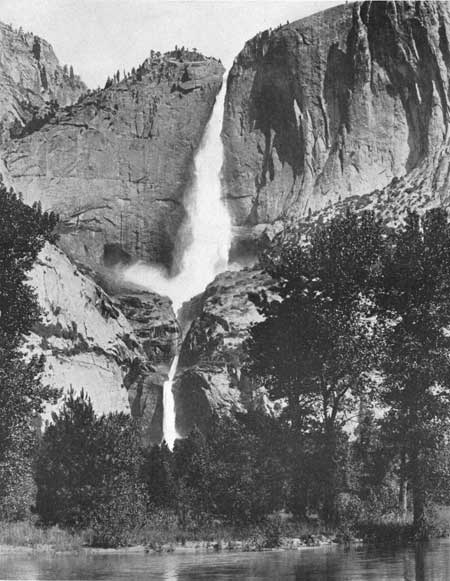
|
| PLATE 22.—THE YOSEMITE FALLS, FROM THE MERCED RIVER. The upper fall, 1,430 feet in height, is probably the highest leaping waterfall in the world. The lower fall, 320 feet in height, is twice as high as the Niagara Falls. The total height of the two falls and the intermediate cascade is 2,565 feet. To the right of the upper fall, partly detached from the cliff, is the pinnacle known as the Lost Archive, about 1,500 feet in height. Photograph by A. C. Pillsbury. |
The Yosemite Falls are composed of a great upper fall, a lesser lower fall, and an intermediate chain of cascades. These have a combined height of 2,565 feet, or almost half a mile, and reach all the way from the upland to the bottom of the valley. The upper fall, which descends directly from the lip of the hanging valley down the front of a sheer, straight cliff, has a height of 1,430 feet. It is, so far as can be ascertained at the time of writing, the highest free-leaping waterfall in existence, It does not, however, clear the entire height of 1,430 feet, The water first cascades tumultuously about 70 feet through a narrow chute worn in the rock face; then, bounding out, it describes a parabolic curve through space, clearing even the bulging lower part of the cliff, which projects more than 100 feet beyond the top. Perhaps a truer conception of the height of the fall will be gained from the statement that it is about nine times as high as the Niagara Falls, The Eiffel Tower in Paris measures 987 feet, or only little over two-thirds the height of the upper Yosemite Fall. Because of the resistance offered by the air, the water in the fall deploys gradually, as it descends, into a broad curtain of lacelike spray. The more concentrated parts, however, shoot down in pointed arrowy masses, resembling comets. The tremendous force with which these water comets strike the slight projections in the cliff front and the rock basin at the foot of the fall is evident from the deafening reports. Involuntarily one looks for falling boulders in the water curtain, but in vain. Incredible it seems that a transparent fabric of mere spray, which at times is flung to one side, or is even lifted bodily by eddying breezes, should impinge so heavily. Muir27 once undertook to pass between fall and cliff on the narrow ledge that extends part way across the cliff front about 450 feet above the base—the Fern Ledge, he called it—but he was well-nigh crushed when a mass of spray swayed against the cliff, and he barely succeeded in groping out alive.
27Muir, John, The Yosemite, pp. 40-42, 1912.
At the foot of the Yosemite Fall the waters, scattered over several acres, again collect in sheets and rivulets that converge toward a half-bowl of polished granite; and thence the stream, remade, dashes away through a narrow, winding gorge. After a boisterous descent of 815 feet it reaches the edge of a recess in the lowermost tier of cliffs and leaps down to the floor of the valley, producing the lower Yosemite Fall. (See pl. 23, C.) This fall, which is 320 feet high, also makes a clear leap at times of high water.
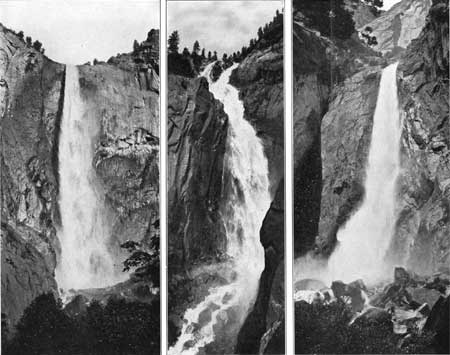
|
|
PLATE 23.—A (left), BRIDALVEIL FALL. Typical
of the free leaping waterfalls of the Yosemite Valley. The Bridalveil
makes an unbroken descent of 620 feet over a vertical precipice. B (center), THE CASCADES. These irregularly tumbling and rebounding cascades, about 500 feet in height, stand in contrast to the leaping falls that prevail in the Yosemite Valley. Photograph by A. C. Pillsbury. C (right), LOWER YOSEMITE FALL. This fall, 320 feet in height, leaps over the side of a peculiar recess sharply incised into the cliffs and terminating in an alcove with overhanging roof. |
Another leaping fall is the Illilouette, 370 feet in height, which descends from the mouth of the hanging valley of Illilouette Creek. Ensconced in a deep gorge, it is visible from only a few directions and is relatively little known, yet it is in point of volume the largest fall made by any of the Merced 's tributaries. In early summer it presents a peculiarly fascinating spectacle, as viewed from the Glacier Point Trail, because the water disappears thundering into a dark abyss of seemingly measureless depth.
The list of falling waters in the Yosemite Valley would scarcely be complete without mention of two minor falls that have each a distinctive character. The first is the Staircase Falls, situated back of Camp Curry, which tumbles, as the name implies, from successive stairlike rock steps. The total height is 1,300 feet. The other is the Royal Arch Cascade, which glides rather than drops down the steeply inclined, smooth cliff face west of the Royal Arches. (See pl. 21, B.) It is a continuous ribbon of rushing, foaming water 1,250 feet in height, the only representative in the valley of a special type of cascade associated with smooth walls of massive granite, of which there are many in the upper Yosemite region and the adjoining parts of the High Sierra.
The Merced Gorge below the Yosemite Valley also abounds in waterfalls. There is one at the mouth of each hanging side valley. Largest are the Cascades (pl. 23, B) at the elbow bend of the gorge, which are formed by the joint waters of Cascade Creek and Tamarack Creek. Unlike most of the major falls of the Yosemite region they are cascades in the real sense, irregularly broken in their descent. They have a total height of about 500 feet.
No part of the Yosemite region is richer in spectacular falling waters than the short stretch of the Merced Canyon that links the Little Yosemite with the main valley. The river there makes a descent of 2,000 feet in a distance of 1-1/2 miles. Throughout the lower half of the canyon the river tumbles in foaming cascades and rapids, but in the upper half it drops from the steps of the giant stairway, producing the Vernal and Nevada Falls. The Vernal Fall (pl. 24) has the form of a broad water curtain 317 feet high that falls from a straight, vertical cliff. It is distinguished from all other falls in the Yosemite region by the partly translucent, soft green hue of undivided water that shines through the foam at its surface. Iridescent clouds of mist rise from the pool and the rocks at the foot of the cliff and eddy about in the canyon, keeping the vegetation fresh and green. It was the suggestion of spring in the scene that inspired Doctor Bunnell28 to name this fall the Vernal. Scarcely less appropriate, however, was the Indian name Yan'o-pah ("cloud of water")
28Bunnell, L. H., Discovery of the Yosemite and the Indian war of 1851, 4th ed., p. 209, 1911.
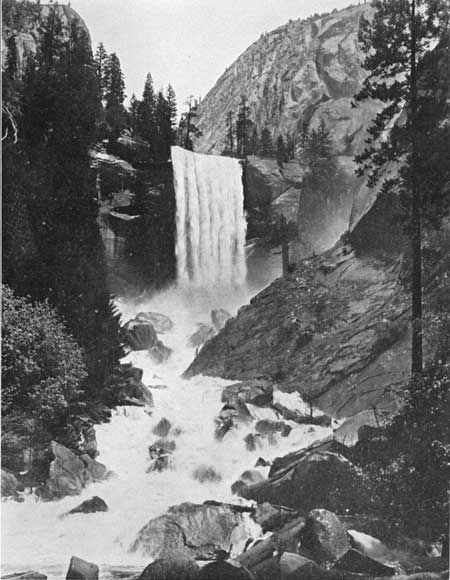
|
| PLATE 24.—VERNAL FALL. The Merced River descends by the Vernal Fall, 317 feet in height, from the lowermost step of the giant stairway. The step is vertical and is composed of unfractured, massive granite throughout. Photograph by A. C. Pillsbury. |
Between the Vernal and Nevada Falls the Merced makes several minor falls and cascades, Only one of these can be described here—the Silver Apron, which ends at the Emerald Pool. In the Silver Apron the water rushes with amazing speed down a gentle incline of smooth granite and spreads, unrestrained, into a broad, thin, sparkling sheet, One small obstruction occurs in the midst of the rock floor, and there the swift waters, leaping up suddenly, form an arched fountain of spray 3 to 5 feet high—a "water wheel," as it is locally termed. Sheet cascades of the Silver Apron type are not uncommon in the High Sierra. They are associated with the smooth floors of massive granite that are characteristic features of a its glaciated canyons. The water wheel in the Silver Apron is but a diminutive example of the much larger fountains of this kind for which the Tuolumne River has become especially famous.
The Nevada Fall (pl. 25) is nearly twice as high as the Vernal—to be precise, it measures 594 feet—but it is far less regular in form. At the top the water issues in wild turmoil from a narrow, constraining channel and fairly flings itself out in a confused mass of downward-shooting rockets of spray. These, as they strike the sloping lower part of the cliff, are flattened out and reunited into a broad, resplendent apron. The dazzling whiteness of the fall suggested the name Nevada, which in Spanish means "snowy." By the Indians it was called Yo-wiye ("twisted fall").

|
| PLATE 25.—NEVADA FALL AND LIBERTY CAP. The Merced here descends from the uppermost step of the giant stairway by a fall 594 feet in height. Only the upper part of the fall leaps clear, the lower part gliding in the form of a spreading apron down the steeply inclined base of the cliff. To the right of the Nevada Fall, and above it, are several typical ribbon cascades. To the left, at the foot of Liberty Cap, is a gulch which the river carved in glacial time. Through it is laid the zigzag trail that leads to the Little Yosemite. |
The Little Yosemite receives no tributary streams of notable volume and consequently is graced by no large waterfalls; but it does possess numerous ribbon cascades similar to the Royal Arch Cascade. Most of these flow only a short time in the early summer, being fed by the snow on the forested uplands. They resemble parallel ribbons of silver filigree. Those on the Cascade Cliffs (pl. 45, A) are fully 1,500 feet in height. As they dry up they leave dark bands or stripes on the cliffs resembling somewhat the stains that disfigure the fronts of city buildings. Their inky hue is produced by minute purplish-black lichens that maintain life on the sun-heated cliffs in spite of the prolonged desiccation which they must endure every year. Longest and most spectacular are the ribbon cascades that glide down the stupendous cliff face of Clouds Rest, on the south side of Tenaya Canyon. They are fed by patches of snow that linger in the shaded recesses until midsummer. They make descents of 2,000 and even 3,000 feet.
On the north side of Tenaya Canyon, a mile above Mirror Lake, are the falls and cascades by which Snow Creek drops from its hanging valley. They have a total height of about 2,000 feet, but, beings deeply ensconced in a gorge of their own cutting, they can not be viewed in their entirety from any one point and are little known to the public. Another waterfall that deserves to be better known is the Tenaya Cascade, which is situated at the head of Tenaya Canyon. It glides down a steeply inclined, marvelously smooth cliff of undivided granite and has a height of about 600 feet. It is strictly a ribbon cascade, but it is the most voluminous and most impressive of its kind; indeed, it is to be counted among the major waterfalls of the Yosemite region.
COMPARISON WITH WATERFALLS IN OTHER PARTS OF THE WORLD
Whether the Yosemite Valley possesses really the highest waterfall in the world is a question of wide interest, and a brief summary of waterfalls of notable height in other regions will thus be appropriate. The time has not yet come, however, when there can be absolute certainty as to which is the highest waterfall in existence; for even to-day the more remote mountain regions of the earth are not completely explored. The following list includes all the high falls of which definite information is at hand at the time of writing. Mile-wide cataracts produced by rivers of large volume, such as the Niagara, Victoria, or Iguazu, are omitted as being in a separate class, Only free-leaping falls are listed, cascades not being considered suitable for comparison.
Among the waterfalls in the United States is, first, the Tueeulala Fall, in the Hetch Hetchy Valley. It is, when at its best, comparable to the upper Yosemite Fall, but it has a total height estimated at about 1,000 feet and makes a clear leap of only 600 feet. The Multnomah Falls, in the gorge of the Columbia River, in Oregon, makes an essentially unbroken descent of about 700 feet. The Snoqualmie Fall, in the State of Washington, is comparable to the Vernal Fall but about 49 feet lower. The lower Yellowstone Fall measures 308 feet in height, or 9 feet less than the Vernal.
The deep fords of the Alaskan coast are rich in falling waters, but most of these have the form of cascades. Muir29 believed that he saw in a bay of the Endicott Arm of Stephens Pass, which he referred to as Yosemite Bay, leaping falls of greater height than those of the Yosemite Valley. The topographic maps of the locality, however, give no hint of the presence of cliffs "five or six thousand feet high," and it seems probable, therefore, that Muir overestimated the height of the waterfalls, as well as of the cliffs.
29Young, S. H., Alaska days with John Muir, pp. 156-159, 1915.
Of the numerous waterfalls in British Columbia the Takakkaw Falls, in the Yoho Valley, are the best known. They make a total descent of 1,346 feet, including a partly free leap of about 900 feet. In the upper Yoho Valley are also the Twin Falls, said to be about 600 feet high. Less well known is the great leaping fall in the upper Bella Coola Valley, which, so far as can be ascertained, is 800, possibly 1,000 feet high.
The numerous waterfalls in the Hawaiian Islands consist mostly of broken cascades. However, the Akaka Falls, above Honomu, on the island of Hawaii, make a free leap of about 400 feet; and the Hiilawe Falls, visible from Waipio Bay, leap fully 500 feet.
The Basaseachic Fall, in the Sierra Tarahumara, of Chihuahua, Mexico, makes a clear leap variously estimated at 827 to 986 feet. In the brief spring season this fall rivals the upper Yosemite in scenic splendor.
The Tequendama Fall, on the Bogota River, Colombia, bears a resemblance to the Nevada Fall. It exceeds that fall in volume but measures about 150 feet less in height.
The Kaieteur Fall, on the Potaro River, British Guiana, is a water curtain of the Vernal type about 740 feet in height. It is one of the highest falls produced by a river of considerable volume.
The most widely known fall of the slender Yosemite type in Europe is the Staubbach, in the valley of Lauterbrunnen, Switzerland. It is about 600 feet high and is comparable to the Bridalveil in volume.
Among the numerous waterfalls that adorn the steep-walled fiords of Norway are the celebrated Vöring Fos, which makes an almost unbroken descent of 850 feet; the Valur Fos, a more irregularly shaped fall 1,150 feet high; and the Vettis Fos, which makes an almost clear leap of 853 feet.
The falls of Gavarnie, situated in an alpine amphitheater of rare beauty on the French side of the Pyrenees, are noted as the highest waterfalls in Europe. They have a height of 1,385 feet—55 feet less than the upper Yosemite Fall—but, owing to the irregular sculpture of the cliffs, they consist, even at times of high water, mostly of broken, interlacing cascades.
The Kalambo River, which forms the boundary between northern Rhodesia and Tanganyika Territory, makes two falls, the upper of which is, so far as can be ascertained, not less than 1,200 feet in height. The volume is probably greater than that of the Merced River.
The Sharavati River, in southern India, descends from the Deccan Plateau by the Gersoppa Falls, which are estimated to be about 830 feet high. Only one of the four falls in the group, the Raja, makes an essentially clear leap.
The Wooloomumbi Fall, on a branch of the Macleay River, in New South Wales, Australia, is about 900 feet high. It not only leaps clear but shoots far out from the cliff, owing to its momentum.
Into the waters of Milford Sound, New Zealand, plunge the Stirling and Bowen Falls. The Stirling makes a fairly regular leap of 504 feet; the Bowen descends in the form of a parted curtain 550 feet in height. Both have a volume comparable to that of the Illilouette. Highest of the New Zealand falls, and among the highest in the world, are the Sutherland Falls, which drop into the canyon of the Arthur River from a typical hanging valley. They consist of a chain of three falls having a combined height of 1,904 feet, Their individual measurements are, beginning with the uppermost, 815, 751, and 338 feet. Only the lowermost makes a clear leap.
From this review it will be seen that the upper Yosemite Fall leads all the other leaping falls thus far known in height. The fact gains in significance when it is considered that the upper Yosemite is but one of a chain of falls having a total height of 2,565 feet, Few regions, besides the Yosemite, possess sheer declivities of that magnitude.
SUMMARY
To sum up this description, the outstanding features of the Yosemite Valley may be listed thus:
1. The spacious U form of the valley, which stands in contrast to the prevailingly narrow V shape of the Merced Canyon above and below the valley; its generally constant width, except for one constriction; and its level floor, which is disproportionately broad for the size of the Merced River,
2. The stepwise mode of ascent of the main branch canyons, which is most accentuated in the giant stairway leading up to the Little Yosemite, less strikingly so in Tenaya Canyon; and the association of a portal-like constriction with each rise and a chamberlike widening with each tread—a recurrence, in other words of more or less typical yosemites at different levels, the Yosemite itself being the largest and lowest of them all.
3. The great height at which the hanging valleys on the flanking uplands terminate at the brinks; and the consequent production of numerous waterfalls; also, the notable lack of uniformity in the height of the hanging valleys, some opening thousands of feet higher than others.
4. The great depth of Tenaya Canyon, which, though the pathway of a small tributary stream, opens essentially at the level of the main chasm; and the relative shallowness of the Little Yosemite, which, though the pathway of the master stream, lies at a level 2,000 feet above the main chasm.
5. The prevailingly massive, simple style of sculpture of the walls; the astonishing diversity of rock forms; and the presence of sheer, straight walls, and rounded domes.
No explanation of the Yosemite's mode of origin would be complete that did not satisfactorily account for all the features enumerated and for the presence of other Yosemite-like valleys in different parts of the Sierra Nevada, The explanation that here follows is in the form, primarily, of a historical account, beginning with the earliest events connected with the origin of the Yosemite as a valley in the Sierra region and tracing its evolution step by step up to the present time. The distinctive shape of the valley and the remarkable sculpture of its walls will thus be seen to be the outcome of a long train of events, a number of processes having acted at different times, under widely differing conditions, upon an assemblage of variously structured rocks.
| <<< Previous | <<< Contents >>> | Next >>> |
pp/160/sec1e.htm
Last Updated: 28-Nov-2006